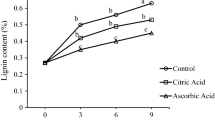Abstract
Acrylamide and 5-hydroxymethylfurfural (HMF) is the product of the Maillard reaction and its accumulation may lead to adverse health effects. Hence, this paper aims to study the effect of l-asparaginase treatment (E100 U/kg and E500 U/kg), frying temperatures (180 °C, 190 °C, 200 °C) and times (2 min, 3 min, 5 min, 7 min) on acrylamide and HMF content after the frying process of curry puff skin. Colour development, moisture content, water activity analysis and sensory evaluation were also carried out. Frying condition at 190 °C for 5 min produced desirable attributes through sensory evaluation. Furthermore, the enzyme reduced the acrylamide and HMF level to 2500 μg/kg and 230 μg/kg respectively. Frying temperature plays a crucial role in acrylamide decomposition leading to the reduction of acrylamide content. Therefore, the use of this enzyme is plausible for the reduction of acrylamide and HMF in puff skin without altering the original quality.





Similar content being viewed by others
References
Abraham K, Rainer G, Berg K, Heinemeyer G, Lampen A. Toxicology and risk assessment of 5-hydroxymethylfurfural in food. Mol. Nutr. Food Res. 55: 667-678 (2011)
Ahn JS, Castle L, Clarke DB, Lloyd AS, Philo MR, Speck DR. Verifications of the findings of acrylamide in heated foods. Food Addit. Contam. A 19: 1116-1124 (2002)
AOAC. Official Methods of Analysis. Association of Official Analytical Chemists, Washington, D.C. (2005)
Capuano E, Ferrigno A, Acampa I, Serpen A, Açar ÖÇ, Gökmen V, Fogliano V. Effect of flour type on Maillard reaction and acrylamide formation during toasting of bread crisp model systems and mitigation strategies. Food Res. Int. 42: 1295-1302 (2009)
Ciesarova Z, Kristina K, Alena B, Francisco J M. Effect of heat treatment and dough formulation on the formation of Maillard reaction products in fine bakery products-benefits and weak points. J. Food Nutr. Res. 48: 20-30 (2009)
Commission Regulation (EC) 466/2001 of 8 March 2001; Setting maximum level for certain contaminants in food stuffs.
Doneva M, Miteva D, Dyankova S, Nacheva I, Metodieva P, Dimov K. Efficiency of plant proteases bromelain and papain on turkey meat tenderness. Biotech. Anim. Husbandry 31: 407-413 (2015)
European Food Safety Authority. Detection and quantification of acrylamide in foods. Available from: https://www.efsa.europa.eu/en/topics/topic/acrylamide. Accessed Dec. 23, 2019.
Gökmen V, Palazoğlu TK, Şenyuva HZ. Relation between the acrylamide formation and time–temperature history of surface and core regions of French fries. J. Food Eng. 77: 972-976 (2006)
Hass G, Michael HA, Donald TG, Hans N. Carboxypeptidase inhibitor from potatoes. The effects of chemical modifications on inhibitory activity. Biochemistry 15: 93-100 (1976)
Hedegaard RV, Frandsen H, Skibsted LH. Kinetics of formation of acrylamide and Schiff base intermediates from asparagine and glucose. Food Chem. 108: 917-925 (2008)
Izydorczyk M. Understanding the chemistry of food carbohydrates. pp 44-47. In: Food Carbohydrates: Chemistry, Physical Properties, and Applications. Cui SW (ed). Taylor and Francis, New York (2005)
Janzowski C, Glaab V, Samimi E, Schlatter J. 5-Hydroxymethylfurfural: assessment of mutagenicity, DNA-damaging potential and reactivity towards cellular glutathione. Food Chem. Toxicol. 38: 801-809 (2000)
Krokida MK, Oreopoulou V, Maroulis ZB, Marinos Kouris D. Colour changes during deep fat frying. J. Food Eng. 48: 219-225 (2001)
Landrock AH, Proctor BE. A new graphical interpolation method for obtaining humidity equilibria data, with special reference to its role in food packaging studies. Food Tech. 5: 332-337 (1951)
Melito HS, Farkas BE. Effect of infrared finishing process parameters on physical, mechanical, and sensory properties of parfried, infrared-finished gluten-free donuts. J. Food Eng. 117: 399-407 (2013)
Miao Y, Zhang H, Zhang L, Wu S, Sun Y, Shan Y, Yuan Y. Acrylamide and 5- hydroxymethylfurfural formation in reconstituted potato chips during frying. J. Food Sci. Tech. 51: 4005-4011 (2014)
National Institute for Occupational Safety and Health (NIOSH). NIOSH Pocket Guide to Chemical Hazards. Available from: https://www.cdc.gov/niosh/npg/npgd0012.html. Accessed Mar. 23, 2020
Nur Fatihah MN, Razinah, S. Health risk assessment of acrylamide in deep fried starchy foods among students of Kolej Tun Syed Nasir, Universiti Kebangsaan Malaysia. Malays. J. Health Sci. 16: 113-117 (2018)
Pedreschi F, Kaack K, Granby K. The effect of asparaginase on acrylamide formation in French fries. Food Chem. 109: 386-392 (2008)
Stadler RH, Blank I, Varga N, Robert F, Hau J, Guy PA, Riediker, S. Food chemistry: acrylamide from Maillard reaction products. Nature 419: 449-450 (2002)
Tardiff R, Gargas M, Kirman C, Carson M, Sweeney L. Estimation of safe dietary intake levels of acrylamide for humans. Food Chem. Toxicol. 48: 658-678 (2009)
Tareke E, Pydberg P, Karlsson E, Tornqvist M. Analysis of acrylamide, a carcinogen formed in heated foodstuffs. J. Agric. Food Chem. 50: 4998-5006 (2002)
World Health Organization. Acrylamide. WHO Food safety. Available from: https://www.who.int/foodsafety/areas_work/chemical-risks/acrylamide/en. Accessed Mar. 23, 2020.
World Health Organization. Acrylamide levels in food should be reduced because of public health concern says UN expert committee. WHO Media centre. Available from: https://www.who.int/mediacentre/news/notes/2005/np06/en/. Accessed Mar. 23, 2020.
Xu F, Oruna-Concha MJ, Elmore JS. The use of asparaginase to reduce acrylamide levels in cooked food. Food Chem. 210: 163-171 (2016)
Zappala M, Fallico B, Arena E, Verzera A. Methods for the determination of HMF in honey: a comparison. Food Contr. 16: 273-277 (2005)
Acknowledgements
This work was supported by Short Term Research Grant (Str17031) awarded by Universiti Kuala Lumpur, Fundamental Research Grant Scheme (FRGS-FRGS/1/2018/STG05/UNIKL/02/8) and Novozyme, Malaysia.
Author information
Authors and Affiliations
Corresponding author
Ethics declarations
Conflict of interest
The authors declare that they have no conflict of interest.
Additional information
Publisher's Note
Springer Nature remains neutral with regard to jurisdictional claims in published maps and institutional affiliations.
Rights and permissions
About this article
Cite this article
Mohd Hashim, M.N., Abd-Talib, N., Yaji, E.L.A. et al. The effect of frying on browning, acrylamide and 5-hydroxymethylfurfural formation on Malaysian curry puff skin treated with l-asparaginase. Food Sci Biotechnol 30, 149–158 (2021). https://doi.org/10.1007/s10068-020-00849-w
Received:
Revised:
Accepted:
Published:
Issue Date:
DOI: https://doi.org/10.1007/s10068-020-00849-w




